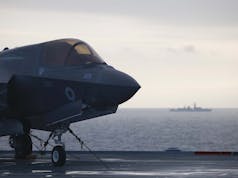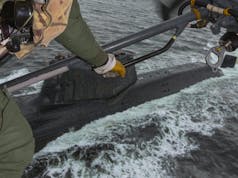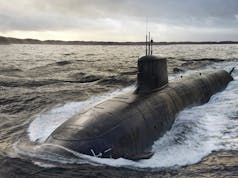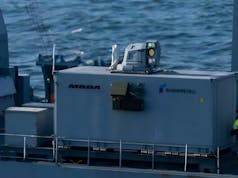During a media briefing at the First Sea Lord’s Sea Power Conference this week, Admiral Sir Ben Key, the First Sea Lord, discussed potential changes in crew sizes for future Royal Navy warships.
His remarks were initially reported by the Telegraph here.
Admiral Sir Ben Key highlighted to the room of journalists that the future Multi Role Support Ships (MRSS) could be operated with significantly fewer crew members compared to current standards. Presently, warships such as the current Albion class require around 400 personnel, but with advancements in technology, the number could be reduced on the newer vessels.
The Royal Navy is looking to incorporate more automated systems and robotics that can handle tasks traditionally performed by sailors. This not only helps address manpower shortages but also reduces the risk to human lives during missions.
While the exact designs and specifications of these future ships are still under consideration, it is clear that the Royal Navy is moving towards a model that prioritises technological integration.
The expected crew would see the number of personnel going to sea fall on most types of ships, depending on the final designs and operational requirements but it’s worth noting that the First Sea Lord was very clear that he doesn’t have any specific numbers in mind.














I have not seen anything about autonomous damage control and this is what is needed if you are going to reduce manning levels significantly.
Best damage control is having two ships instead of one and you can only have two ships if you have a smaller crew.
Hi Paul, I think we have seen the beginning of the DC revolution. I’m late of QNLZ and spent hours of my life in HQ1 over the last few years. Whilst there is far more work to be done, simple transitions like fixed monitoring in engineering spaces, flood detectors in every major compartment below the waterline and the ability to monitor WTI via sensors on doors all contributed to a much more automated and realistic picture of the DC effort. As DCO I was able to pull up CCTV in most major spaces and had access to a wealth of fixed systems (some autonomous such as fixed water sprays and some manually controlled with a higher risk to life.) I had a near-real time interactive digital picture and didn’t once need to use a chingraph! We are on the first steps of an experimental journey, but I think it is something we can be rightly proud of and I would argue that we continue to set the standard.
One area we do need to focus on is our attitude to risk differing states of DC readiness; the ‘establishment’ embracing these technologies as suitable replacement for a sailor on the ground; and learning how we can better train with autonomous systems. My experience with FOST was both credible and frustrating in equal measure (as are many peoples) but we were able to embrace the new ways of working and hopefully left the enterprise in a better position than we started. Our SSEP was c.70 people which considering the real estate (c.12 acres, 5km of flats etc etc) is perhaps as lean as one could hope for on a warship.
All for making the DCO/OOD/Section Base life easier. We had a lot of systems of a similar ilk on Bulwark. Some where a boon …others not so much.
Flood sensors, fire sensors, heat sensors, CCTV, door and hatch sensors = ✅
DC boards on screens? I was not a fan. Unlike the age old DC State Board and chinagraph/perm marker pen I and many others found that you cannot really see the overall picture at a glance. I found that you ended up zooming in on an area of concern and were missing the other things around it. Even later when we trialled a massive magiboard it was still an issue to see incidents, locations, and the interaction with other parts of the vessel especially between multiple decks and adjacent compartments(Main box incidents) . The granularity just wasn’t there.
SSEP and DC teams where less on Bulwark but not by that much…we had the advantage of Royal being onboard to move things around and to be a pool of spare hands when needed and at times they were…AFFF containers and timber to move…call Royal! You will always need people for re-entry teams, leak stopping and boundary cooling whilst still trying to do BDR and fight the ship…crewing levels will reach a plateau and despite wanting to be lean, tech isn’t going to fix the need for bums on seats or bods in BA .
We did hack FOST off in the WE Section Base a lot. The important stuff everyone pays attention to without question…They learn, we learn and as you said RN DC and FOST set the standard for other navys to follow.
But somethings …. The “old knock the lights off” trick to make things difficult and to increase stress didn’t work. White lights with 2 power supplies off the mains via ACOS, a third hard wired supply via battery inverters on an ACOS, a fourth via a DC cable run to the inverter. Then, if needed, DC Lamps, Headlamps and B&Q push to operate battery wardrobe lights …they gave up and ended up pulling lamps out of the fittings …which we replaced with “Emergency resupply lamps” from the cabinets in the section base… As ever it was a kind of “Us and Them” FOST game played out by everyone who gets a visit from them…Builds the onboard teams spirit and teamwork especially when done with the sometimes twisted matelot humour…
Have they have moved away from Bleep Phones now for emergency backup to emergency backup comms…My hearing is knacked due to getting bleeped with that thing next to my ear which was usually followed by me doing some very creative swearing and then throwing the thing across the section base…scattering my lads, lasses and the DWEO with cries of “Incoming” from them! There must be a better way by now.
the only real way you could get that would be a halon gas outlet in every compartment in the ship which would need huge space taking room in the ships deign.might have saved Sheffield and ardent in 1882. where fired couldn’t be extinguished fast enough and the damage to the actual structure led to the loss of the vessel.
The only way forward is to build naval vessels with less manning in terms of electronic warfare. AI will play a huge role in the transition to more automation and even some seamanship will be included. As for seamanship, docking, cleaning, servicing and general maintenance, manning levels will still need to be workable. However, the days of large crewed vessels are no longer sustainable with a changing public mindset about being part of the services. Luckily, technology is stepping up to the plate and bringing the advent of autonomous drones both above and below the water into active service in the medium future.
Still need maintainers…Still need operators when the auto primary system goes down and you revert to back up secondary operation.v Still need loaders for weapon systems.
You can go lean but you lose Operational Capability after a point because you cannot sustain the work load. USN has big issues with this on LCS. Tired crew due to wearing many hats and long watches resulting in mechanical defects caused by poor maint or near collisions from tired bridge watch keepers
Gunbuster, I’m looking at remote control of much of the tech ops and the same control networked through two or three centres. Tech ops will still be required on board and a chain of immediate command but just much fewer than today.
We are literally building and operating ships with a crew of zero so the concept of getting the crew of a frigate down from 130 to 50 should be a piece of piss.
Who’s going to fix the AI/robots/automated systems when they go wrong or take battle damage?
French just increased again the crew size in their FREMMs.
Less crew is great when everything is working! It’s when it fails that manpower is needed. When we would come alongside I would be working for hours in the cold when the other half of the crew would be queuing in their civvies waiting for the gangway to go down!!
👍
Been there …done that…
If alongside “Logs and OPS Dept Leave! Leave until 2359. Ship is under sailing orders”
“WE/ME Dept Leave! …Leave your 8s/4s/Overalls on there isn’t any!”
Why do I think we will see more breakdowns /accident due to the reduced crews to properly monitor stuff. Plus I assume longer maintance periods caused by it.
The various crashes /sinking of ally ships in recent years have come down to this.
It will be interesting to see how many crew the RFA will need to man MRSS? At present LSDA run with a minimum of 69 which increases dependant on operations. That said as a crew with addition RN is generally less than 100!!!!!! The most important thing to consider is system engineering as all this tech required substantial maintenance!!!